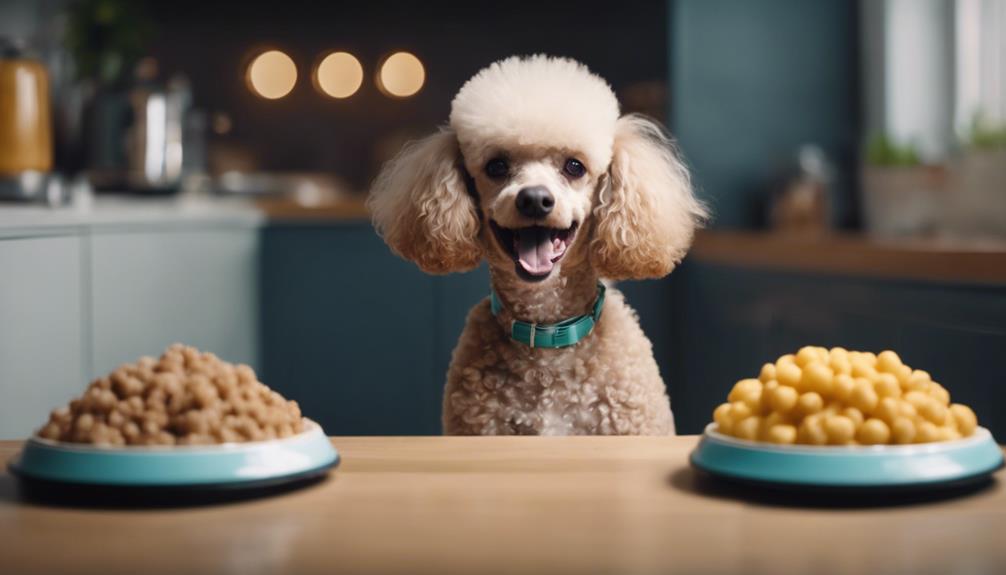When it comes to your poodle’s diet, navigating food changes can be like embarking on a winding path through a forest, each turn leading to a different nutritional destination. But how do you know when to veer off the familiar route of your poodle’s current food choice? Understanding the intricacies of transitioning your poodle’s diet can be the key to unlocking a healthier and happier pup.
Key Takeaways
- Gradual transition over 7-10 days minimizes digestive issues and helps the stomach adapt smoothly.
- Tailor food based on size, energy levels, and health needs with proper protein and fat levels.
- Monitor for signs like behavioral changes, coat or skin problems, and digestive issues indicating a needed food change.
- Consider preferences, nutritional needs, and vet consultations for a successful and tailored diet transition.
Importance of Transitioning Dog Food
Gradually transitioning your poodle’s diet is a crucial step to ensure a smooth adjustment for their stomach and overall well-being. This gradual transition helps minimize digestive issues and allows your dog’s stomach to adapt over a period of 7-10 days. By mixing the old and new food in specific proportions over different days, you can ease the switch for your furry friend. Timing the transition is also vital; factors such as age, weight, activity levels, and health needs should be considered to support your poodle’s well-being.
Sudden changes in your poodle’s diet can shock their digestive system, potentially leading to health issues and discomfort. By monitoring your dog’s response during the transition period, you can promptly address any digestive concerns that may arise. Remember, a gradual transition is a thoughtful way to introduce new foods, ensuring a happier and healthier adjustment for your beloved poodle.
Understanding Poodle Dietary Needs
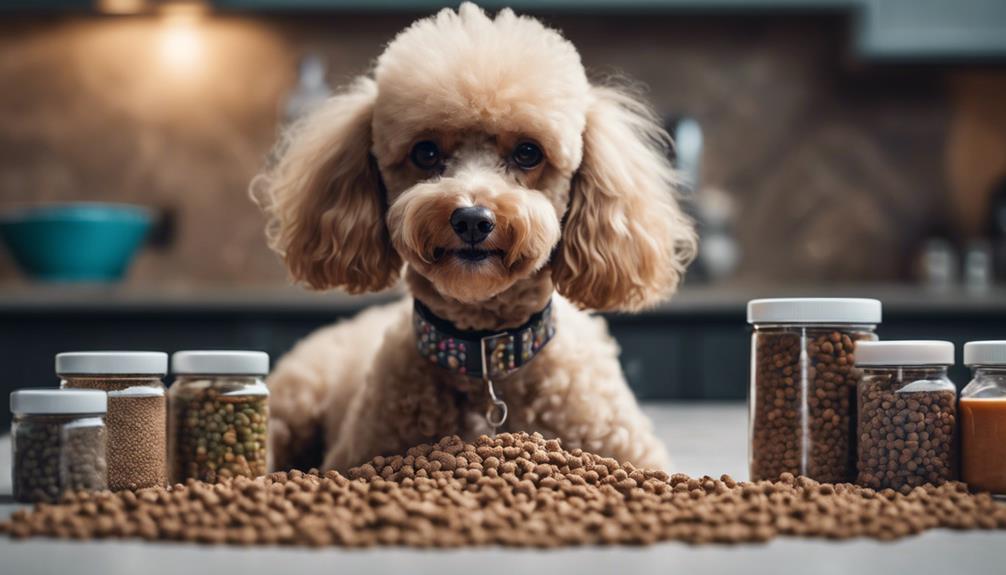
To ensure your toy poodle’s well-being, it’s vital to understand their specific dietary needs. Proper protein and fat levels are crucial for their energy and overall health. Regular vet consultations can help tailor a diet that meets your poodle’s nutritional requirements.
Poodle’s Nutritional Requirements
Understanding the nutritional requirements of Poodles is essential for ensuring their overall health and well-being. Toy poodles, in particular, need a balanced diet with appropriate protein and fat content tailored to their size and energy levels. Opting for nutrient-rich food can contribute to their coat health and support a robust immune system. Regular vet check-ups play a vital role in evaluating if a toy poodle’s diet adequately meets their specific nutritional needs. For toy poodles with specific health conditions or dietary deficiencies, supplements might be necessary. Monitoring your toy poodle’s weight and adjusting food portions accordingly are crucial steps in maintaining their health and well-being. By paying attention to these details, you can help your furry friend thrive.
Meal Transition Tips
Transitioning your poodle’s meals over a period of 7-10 days can help minimize digestive issues and ensure a smooth adjustment to new food. When switching foods, follow a feeding guide by gradually incorporating the new food into your poodle’s current diet. Start by mixing 25% of the new food with 75% of the old food for the first two days, then increase the new food to 50% for the next two days, and so on. Understanding your poodle’s nutritional needs is key to maintaining a balanced diet during the switch. Monitor their response closely for any signs of digestive issues or health concerns. Consider their preferences to cater to individual tastes and ensure a successful transition to a new and nourishing diet.
Signs Your Poodle Needs a Food Change
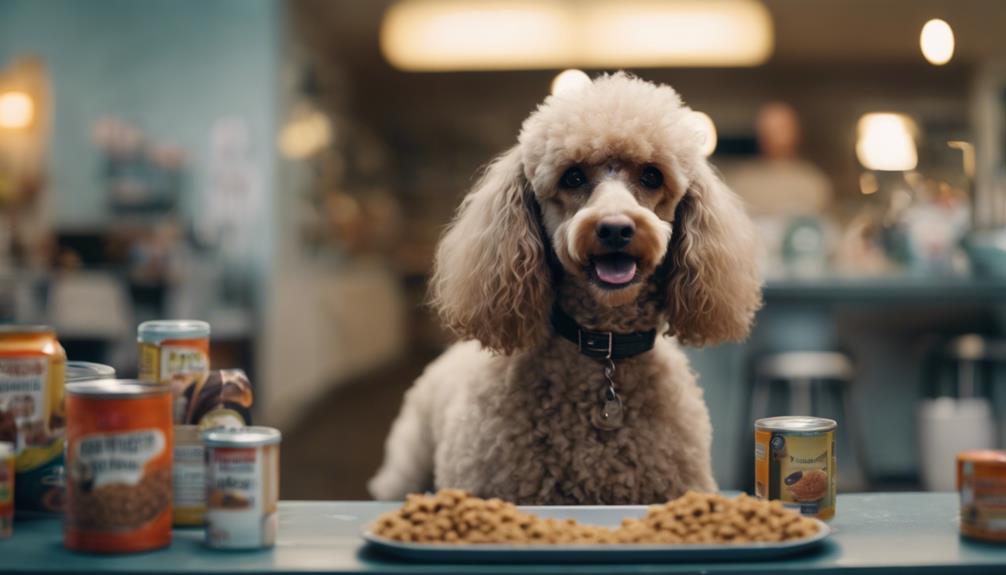
If your poodle is showing behavioral changes like increased irritability or decreased activity levels, it could be a sign that a food change is needed. Persistent digestive issues such as diarrhea or vomiting are clear indicators that your poodle’s current diet may not be suitable. Additionally, coat or skin problems like dull fur, excessive itching, or hot spots should prompt consideration of switching your poodle’s food.
Behavioral Changes Indicate
Behavioral changes in your poodle, such as decreased energy levels or sudden weight loss, can serve as clear indicators that a food change may be necessary. If you notice your poodle becoming picky with its meals, displaying a dull coat, or experiencing skin issues, it could be a signal that its current food is not providing adequate nutrition. Sudden shifts in behavior like increased food aggression or disinterest in eating may also point to dissatisfaction with the current food choice. Regularly monitoring your poodle’s behavior, physical health, and appetite is crucial in identifying when it’s time to switch dog food. Paying attention to these signs allows you to address any potential dietary issues promptly and ensure your poodle’s overall well-being.
Digestive Issues Persist
Persistent digestive issues in your poodle, such as vomiting or diarrhea, can be strong indicators that a change in their food may be necessary. Flatulence, bloating, or stomach discomfort after meals could also signify that their current diet is not suiting them. Sudden changes in appetite or unexplained weight loss might be linked to their food. If you notice your poodle experiencing gastrointestinal distress like frequent constipation or loose stools, it’s time to consider a new food. To help you check the feeding, here is a table to guide you:
| Signs of Digestive Issues in Your Poodle |
|---|
| Vomiting or Diarrhea |
| Flatulence or Bloating |
| Sudden Changes in Appetite or Weight |
| Gastrointestinal Distress |
Coat or Skin Problems
Skin problems like itching, redness, or flakiness in your poodle could be clear indicators that a dietary change is needed. If you notice your poodle’s coat looking dull, brittle, or dry, it might be a sign that the current diet lacks essential nutrients. Allergies, hot spots, or excessive shedding could point to food sensitivities that require adjustments in their food. Gastrointestinal issues such as diarrhea, vomiting, or gas may suggest a need for a more suitable food choice for your poodle. Additionally, if your poodle lacks energy, seems lethargic, or displays mood changes, these could be linked to nutritional deficiencies that a new diet could help address. Be attentive to these signs, especially when transitioning your poodle from puppy to adult, to ensure they receive the right amount of current nutrients.
Transitioning From Puppy to Adult Food
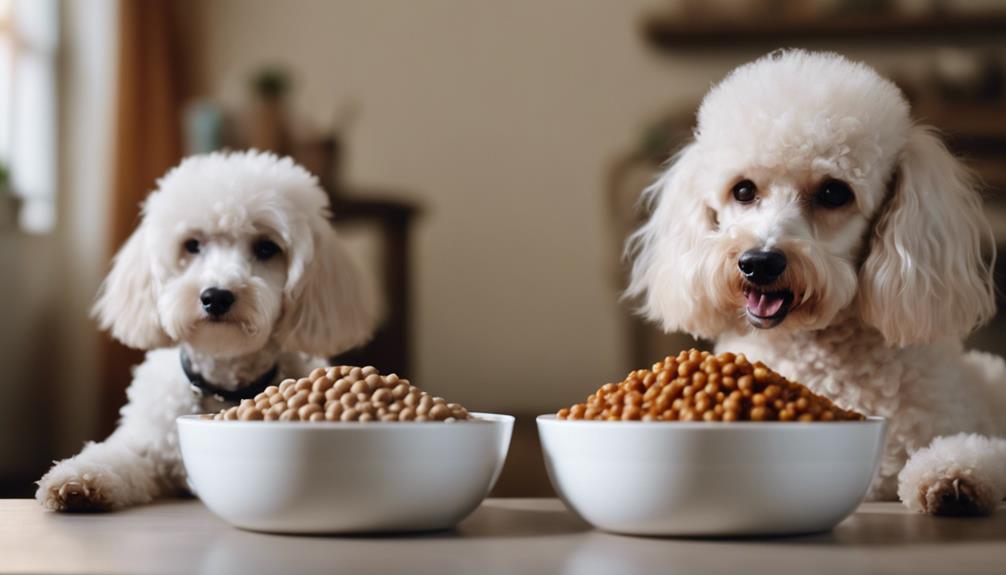
When transitioning your toy poodle from puppy to adult food, a gradual process is crucial to minimize digestive issues and ensure optimal nutrition. Here’s how to smoothly shift your furry friend to their new diet:
- Timing is Key: Puppies typically require the transition to adult dog food around their first birthday to support their growth and development adequately.
- Slow and Steady Wins the Race: Gradually introduce the new adult food by mixing it with the old puppy food over 7-10 days. This method helps your toy poodle adjust smoothly.
- Consider Individual Factors: Factors like your poodle’s size, breed, behavior, and vet recommendations can influence the timing of the switch. Consult with your vet for personalized advice.
- Balance is Essential: Switching too early or too late from puppy to adult food can impact your toy poodle’s health and overall well-being. Ensure a balanced transition for their optimal growth.
Choosing the Right Food for Your Poodle
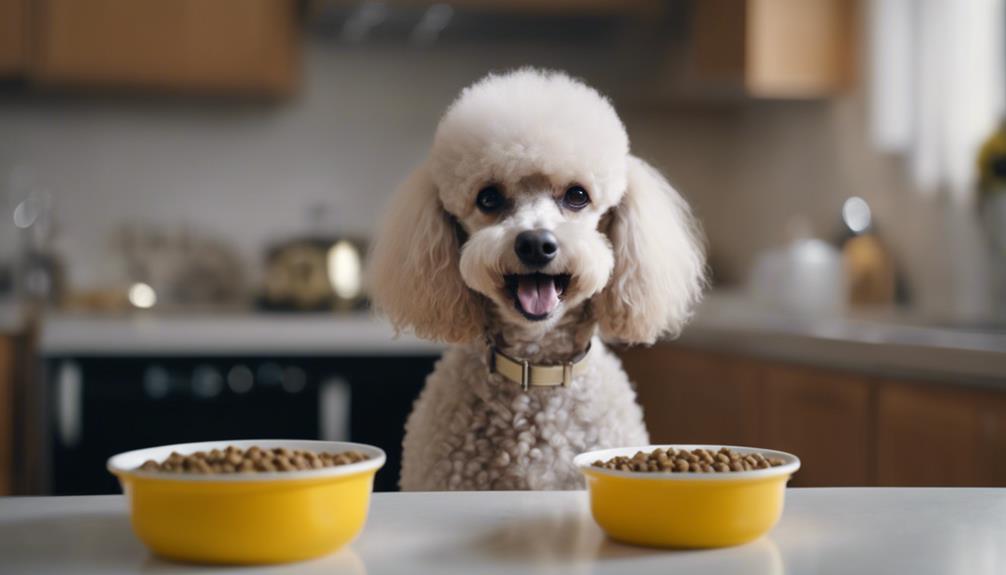
When selecting food for your poodle, take into account factors like age, weight, activity level, and health status to ensure optimal nutrition. Your veterinarian can provide valuable insights into choosing a diet that suits your poodle’s specific requirements. Look for dog food brands that offer balanced nutrition tailored to meet the needs of small breeds like poodles.
Poodle Dietary Requirements
To ensure optimal health and vitality for your poodle, selecting a well-balanced diet rich in essential nutrients is paramount. Here are some key points to consider when meeting your poodle’s dietary requirements:
- Protein and Fat Content: Poodles require a diet with appropriate levels of protein and fat to support their energy needs and overall health.
- Nutrient-Rich Food: Opt for high-quality food that is nutrient-rich to promote a healthy coat and strong immune system for your poodle.
- Regular Vet Check-ups: Schedule routine vet visits to assess if your poodle’s current diet aligns with their nutritional needs.
- Supplements and Weight Monitoring: Supplements may be necessary based on specific health conditions, and monitoring your poodle’s weight to adjust food portions is crucial for their well-being.
Nutritional Considerations for Poodles
Ensuring your poodle’s optimal health and vitality begins with carefully selecting the right food to meet their specific nutritional needs. Poodles, whether puppies or adults, require a balanced diet rich in appropriate protein and fat content to support their energy levels and overall well-being. Regular vet check-ups play a crucial role in determining if the current diet adequately meets your poodle’s nutritional requirements. Monitoring your poodle’s body condition and adjusting food portions accordingly is essential for maintaining their ideal weight and overall health. Additionally, nutrient-rich food is vital for promoting a poodle’s coat health, energy levels, and overall well-being. Consider supplements if your poodle has specific health conditions or deficiencies to ensure they receive all necessary nutrients for a healthy life.
Special Dietary Needs
Considering your poodle’s individual characteristics such as age, weight, activity level, and health status is essential when selecting the appropriate food to meet their special dietary needs. Here are some key points to keep in mind when choosing the right food for your poodle:
- Look for balanced formulas with appropriate protein and fat content tailored to your poodle’s nutritional requirements.
- Consult with your veterinarian to determine if your poodle requires any specific dietary considerations or supplements.
- Monitor your poodle’s weight regularly and adjust food portions accordingly to maintain a healthy body condition.
- Opt for high-quality dog foods as they can contribute significantly to your poodle’s coat health, energy levels, and overall well-being.
Transitioning to a New Dog Food Brand
When transitioning your dog to a new food brand, gradually introducing the new food alongside their current diet can help minimize digestive issues and ensure a smooth adjustment process. It’s essential to consider factors like price, ingredients, and the impact on coat health when making the switch to a new dog food brand like Blue Buffalo or Pedigree. Upgrading to a higher-quality brand can have significant benefits for your dog’s overall health and well-being. However, before making any changes, it’s crucial to consult with your vet to ensure that the new brand aligns with your dog’s specific dietary needs.
Transitioning between dog food brands should be done gradually to minimize any potential digestive upset. By mixing the old and new food together over a period of 7-10 days, you can help your dog adjust comfortably. This method allows your dog’s digestive system to adapt slowly to the new ingredients, reducing the likelihood of stomach issues. Remember, a gradual transition is key to a successful switch to a new dog food brand.
Gradual Vs. Immediate Food Switch
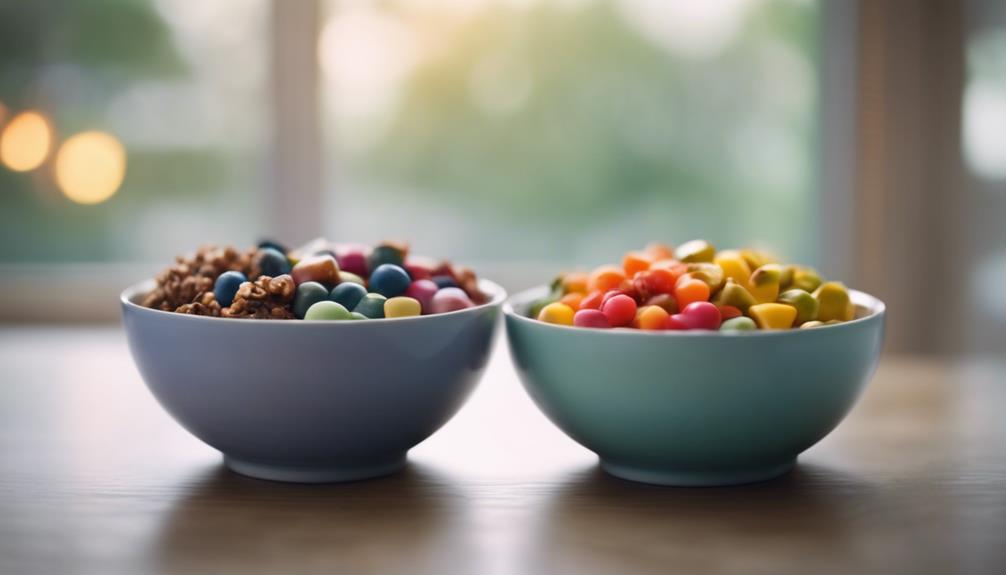
To ensure your dog’s digestive system adjusts smoothly to a new food brand, it is advisable to introduce the new food gradually rather than making an immediate switch. Here’s why a gradual transition is beneficial for your poodle’s feeding routine and stomach health:
- Reduced Stomach Upset: Gradual food switches over 7-10 days reduce digestive issues and allow the dog’s stomach to adjust, minimizing the chances of stomach upset.
- Prevention of Health Issues: Immediate switches may shock the digestive system and lead to potential health issues, making a gradual change a safer option for your furry friend.
- Monitoring for Adverse Reactions: Monitoring the dog’s health during the transition period is crucial for assessing any adverse reactions and addressing them promptly.
- Adaptation of Gut Biome: Gradual transitions help the gut biome adapt to new foods and prevent food-related allergies, ensuring your poodle’s digestive system remains healthy and balanced.
Factors to Consider Before Changing Food
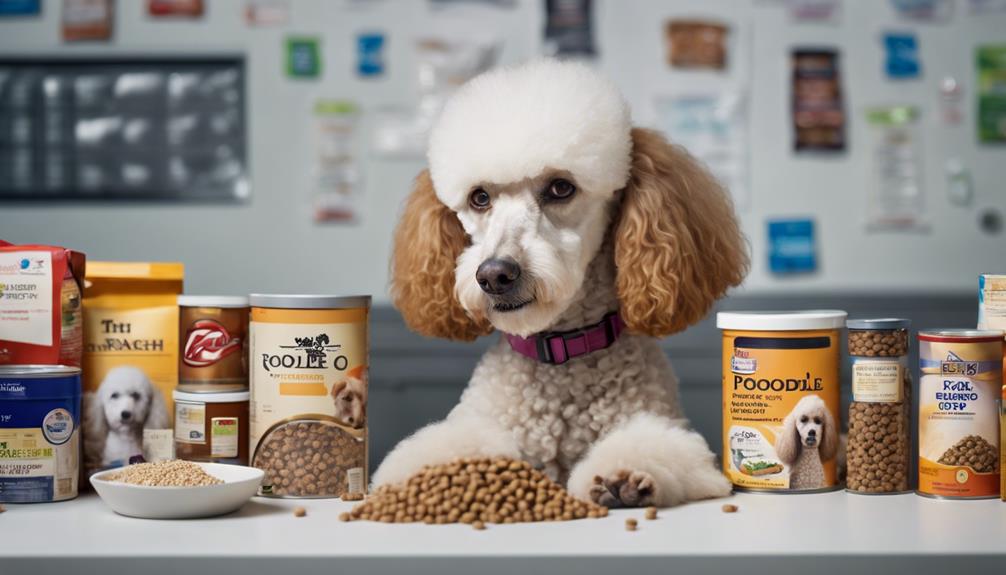
Before making any changes to your poodle’s diet, it is essential to carefully evaluate factors such as age, weight, activity level, health conditions, and taste preferences. Age is a significant consideration as puppies, adults, and seniors have different nutritional requirements. For instance, puppies require more protein and calories for growth and development, while senior poodles may benefit from diets tailored to joint health. Weight management is crucial, especially for overweight or underweight poodles. Adjusting the amount and type of food can help maintain a healthy weight. Health conditions like gastrointestinal issues may indicate the need for a specialized diet change. Understanding your poodle’s taste preferences can guide you in selecting a food that suits its palate, ensuring they enjoy their meals. When transitioning to adult dog food, consider these factors to provide your poodle with the best nutrition tailored to their specific needs.
Common Mistakes to Avoid in Diet Transition
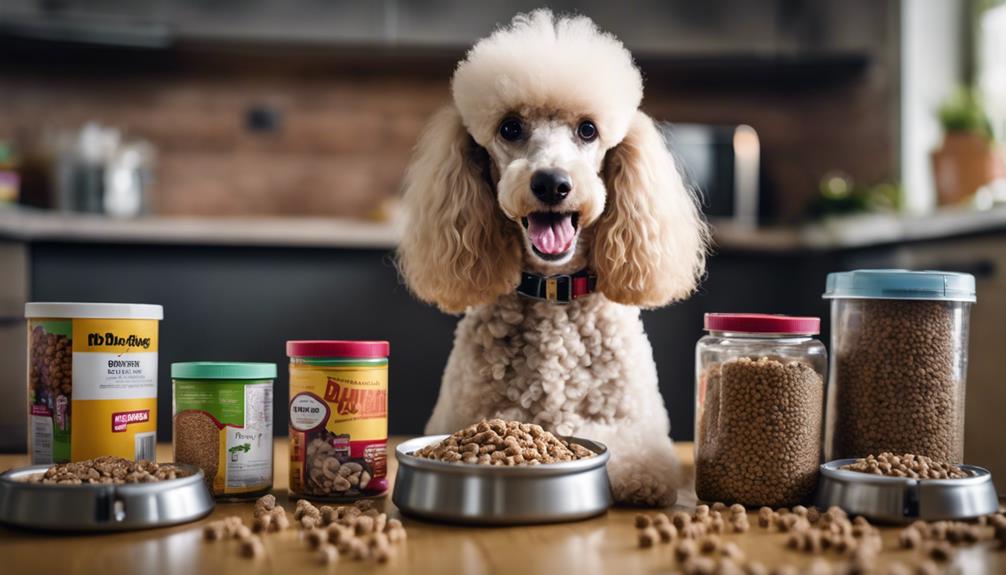
Transitioning your poodle’s diet requires careful attention to avoid common mistakes that can impact their digestive health and overall well-being. To ensure a smooth transition, here are some common mistakes to avoid when switching your dog’s food:
- Rushing the Process: Hastily changing your dog’s diet can lead to digestive upset and discomfort in poodles. Gradually introducing the new food is key to preventing potential issues.
- Ignoring Gradual Change: Poodles may be reluctant to eat the new food if the transition is too abrupt. Slowly mixing the old and new food over a period of time can help them adjust.
- Failing to Monitor Response: Not paying attention to how your poodle responds to the new diet can hinder a successful transition. Watch for any signs of digestive issues or reluctance to eat.
- Neglecting Vet Consultation: Consulting with a veterinarian about the transition plan is crucial. They can provide guidance tailored to your poodle’s specific health needs, ensuring a smooth switch that considers any underlying health conditions.
Royal Canin Poodle Puppy Breed Specific Dry Dog Food, 2.5 lb bag
Features
| Is Discontinued By Manufacturer | No |
| Product Dimensions | 12 x 7.5 x 4 inches; 2.5 Pounds |
| Manufacturer recommended age | 1 month and up |
| Item model number | 510925 |
| Date First Available | April 2, 2014 |
| Manufacturer | Royal Canin |
| ASIN | B00JN9LSN2 |
| Country of Origin | USA |
- FORMULATED FOR PUREBRED POODLES: Royal Canin Poodle Puppy Dry Dog Food is designed to meet the nutritional needs of purebred Poodles 8 weeks to 10 months old
- SPECIALIZED KIBBLE: Unique kibble design helps Poodles easily pick up and chew their food
- HEALTHY DEVELOPMENT: An exclusive complex of antioxidants, including vitamin E, helps support puppy development of the immune system
- SKIN AND COAT: EPA and DHA from fish oil promote healthy skin and coat to help nourish puppy’s developing curly coat
- OPTIMAL STOOL: Supports healthy digestion in puppies and promotes optimal stool quality with high-quality proteins and prebiotics
Royal Canin Poodle Adult Breed Specific Dry Dog Food, 10 lb bag
- Royal Canin Poodle Adult dry dog food is designed to meet the nutritional needs of purebred Poodles 10 months and older
- Exclusive kibble design helps Poodles easily pick up and chew their food
- Helps maintain a Poodle’s coat health with EPA and DHA fatty acids from fish oil and precise protein levels to support continuously growing hair
- Supports a Poodle’s strong build with precise protein content to maintain muscle tone
- An exclusive blend of nutrients supports vitality and healthy aging during their long life span
Royal Canin Breed Health Nutrition Poodle 8+ Adult Dry Dog Food, 3 lb bag
Features
| Product Dimensions | 4 x 7.5 x 12 inches; 3 Pounds |
| Manufacturer recommended age | 1 month and up |
| Item model number | 519803 |
| Date First Available | December 5, 2017 |
| Manufacturer | Royal Canin |
| ASIN | B077Y6VTY8 |
| Country of Origin | USA |
- FORMULATED FOR PUREBRED POODLES: Royal Canin Poodle Adult 8+ Dry Dog Food is designed to meet the nutritional needs of purebred senior Poodles 8 years and older
- SPECIALIZED KIBBLE: Unique kibble is rehydratable and can be mixed with warm water, making it easy for aging dogs to chew and eat
- HEALTHY AGING: Supports healthy aging for senior dogs into the golden years with precise phosphorus content and an exclusive complex of antioxidants
- HEART HEALTH: A blend of key nutrients, including taurine and omega-3 fatty acids, helps maintain heart health in mature Poodles
- HEALTHY COAT: EPA and DHA fatty acids from fish oil and precise protein levels support coat care and help maintain healthy skin and coat
Handling Food Allergies in Poodles
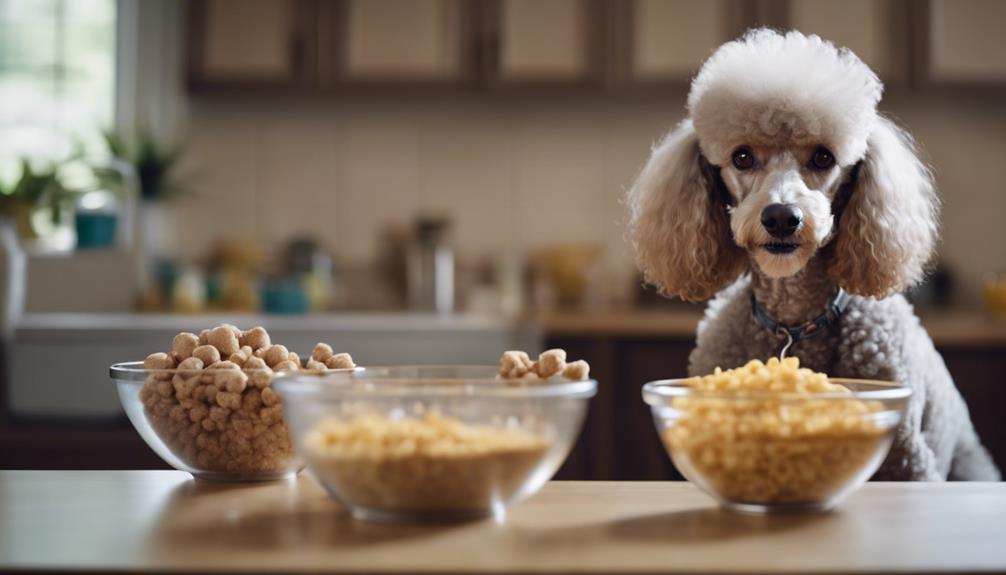
If your poodle is showing signs of food allergies like itching, digestive issues, or skin problems, it’s crucial to consider allergy testing to pinpoint the specific triggers. Common allergens for poodles include beef, chicken, dairy, wheat, soy, and corn, which may require switching to a limited ingredient or hypoallergenic diet. Consult with your veterinarian to develop a personalized plan for managing your poodle’s food allergies effectively.
Allergy Testing Options
When handling food allergies in your poodle, exploring allergy testing options such as blood tests, skin tests, and elimination diets is essential for pinpointing specific allergens affecting your pet’s health.
- Blood Tests: Measure antibodies in the blood to specific food allergens, aiding in identifying allergic reactions in poodles.
- Skin Tests: Involve exposing the poodle’s skin to small amounts of allergens to observe reactions, helping pinpoint food allergies.
- Elimination Diets: Require removing potential food triggers and reintroducing them methodically to identify allergens impacting the poodle.
- Importance: Identifying and managing food allergies in poodles is crucial for their health and well-being, necessitating accurate testing and appropriate dietary adjustments.
Symptom Management Strategies
To effectively manage food allergies in your poodle, implementing symptom management strategies is crucial for improving your pet’s health and well-being. When dealing with food allergies, it’s important to address the current symptoms your poodle may be experiencing. Common signs of food allergies in poodles include itching, redness, hair loss, and digestive issues like vomiting or diarrhea. Below is a table outlining practical symptom management strategies that you can implement to help your poodle feel better:
| Symptom Management Strategies | Description |
|---|---|
| Skin Issues | Use gentle shampoos, consider topical treatments. |
| Gastrointestinal Problems | Switch to hypoallergenic or limited ingredient diets. |
| Chronic Ear Infections | Regular cleaning and vet-prescribed ear drops. |
| General Discomfort | Monitor symptoms closely, consult your veterinarian. |
Monitoring Your Poodle’s Response to New Food
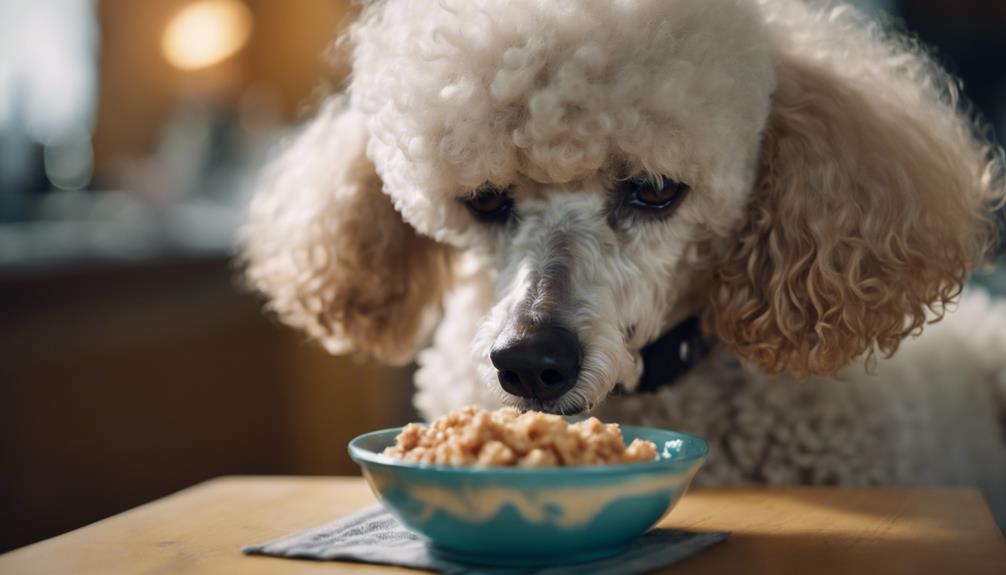
During the transition period to a new diet for your poodle, closely observe any changes in their stool consistency and frequency. This observation can provide valuable insights into how well your poodle is adjusting to the new adult food. Here are some essential tips to monitor your poodle’s response to the new food:
- Stool Changes: Check for any differences in your poodle’s stool, such as diarrhea, constipation, or unusual colors, which may indicate digestive issues.
- Energy Levels: Monitor your poodle’s energy levels post-meal; a lack of energy could signify a problem with the new diet.
- Allergic Reactions: Watch out for signs of allergies like itching, redness, or digestive problems, as these could signal an intolerance to certain ingredients.
- Coat and Skin: Note any improvements or deterioration in your poodle’s coat quality, shine, or skin health, as these can be reflective of the new diet’s impact.
Including Variety in Your Poodle’s Diet
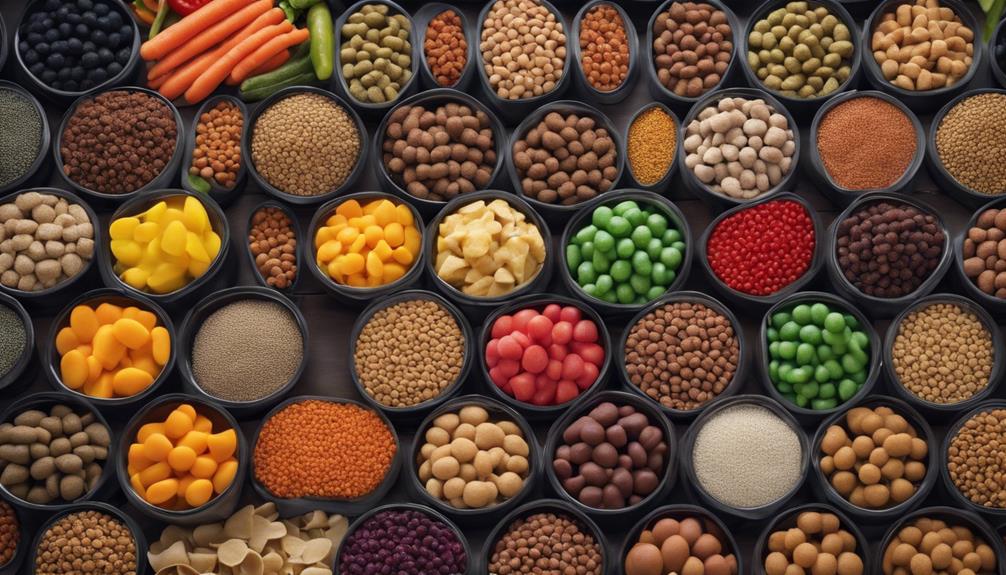
To ensure optimal nutrition and overall well-being for your poodle, incorporating a variety of foods in their diet is essential. Introducing different protein sources such as chicken, beef, and fish can help meet your poodle’s nutritional needs. Varying the proteins not only prevents mealtime boredom but also provides a range of essential nutrients. Additionally, including fruits and vegetables as treats or meal toppers can add vitamins and fiber to your poodle’s diet, promoting overall health. Rotating between wet and dry food options is another way to keep mealtime interesting for your furry friend. Experimenting with homemade dog food recipes is a fantastic way to give your poodle a diverse and balanced diet. Homemade meals allow you to control the ingredients, ensuring your poodle receives high-quality nutrition. By incorporating variety in your poodle’s diet through these methods, you can support their health and happiness.
Seeking Veterinary Advice for Diet Changes
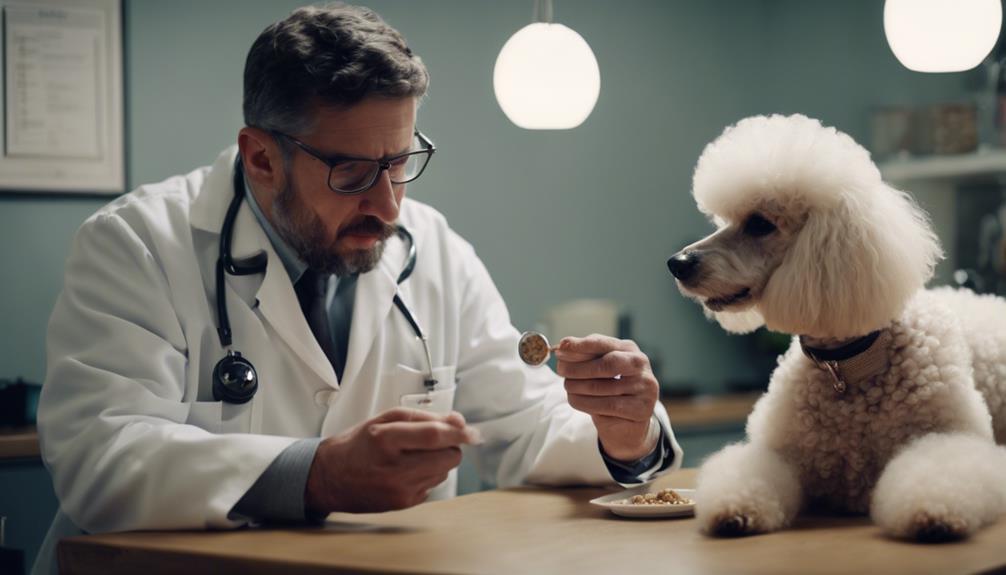
Before making significant changes to your poodle’s diet, consulting a veterinarian is crucial to ensure their nutritional needs are met and any health concerns are addressed. Here’s why seeking veterinary advice is important:
- Timing and Process: Vets can offer guidance on how to transition your poodle to a new diet over a day or two, minimizing digestive upsets.
- Nutritional Needs: Veterinarians ensure that the new food meets your poodle’s specific nutritional requirements based on factors like age, breed, and activity level.
- Health Conditions: Vets can identify any underlying health conditions that may affect your poodle’s dietary changes, ensuring the new diet supports their overall well-being.
- Addressing Concerns: Veterinary input is crucial in addressing any issues that may arise during the switch from the old dog food to the new one, providing solutions tailored to your poodle’s needs.
Long-Term Diet Maintenance for Poodles
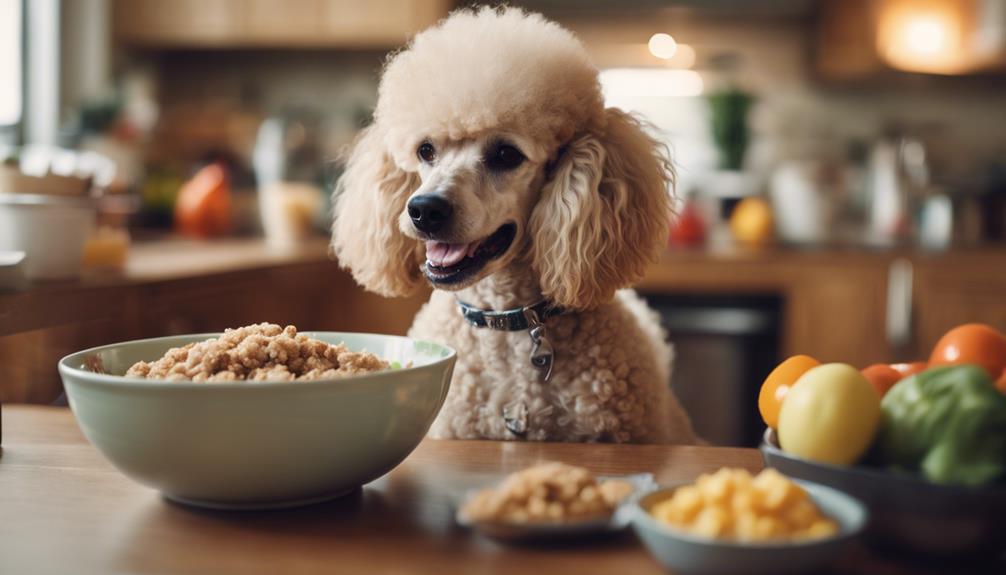
Guidance from your veterinarian plays a crucial role in ensuring the long-term maintenance of your poodle’s diet, encompassing a balanced intake of necessary nutrients to support their overall health and well-being. To maintain your poodle’s ideal body weight, it’s essential to provide a diet with appropriate protein and fat content. Regular vet check-ups are vital for assessing if the current diet meets your poodle’s nutritional needs. Monitoring your poodle’s weight is key; adjust food portions accordingly to prevent under or overfeeding. Supplements may be necessary to address specific health conditions or dietary deficiencies in your poodle’s diet. Proper nutrition not only supports your poodle’s coat health and energy levels but also contributes to their overall well-being in the long term. Remember, a balanced diet and consistent monitoring are crucial for keeping your poodle healthy and happy throughout their life.
Frequently Asked Questions
When Should I Switch My Poodle to Adult Food?
When it’s time to switch your poodle to adult food, consider their growth stage. Puppies around one year might benefit from transitioning. Senior dogs at seven could use a senior diet. Remember, gradual changes are easier on their digestion. Consult your vet for personalized advice.
How Do You Switch and Transition Dog Food?
When switching dog food, remember to transition gradually over 7-10 days. Start by mixing the new food with the old, increasing ratios over time. This method prevents digestive issues and helps your dog adjust smoothly.
How Long Does It Take for a Dog to Get Used to a Food Change?
Adjusting to a new food can take around 7-10 days for dogs. During the transition period, gradually mix current and new food to aid digestion. Monitor your Poodle’s response and adjust as needed for a smooth change.
How Do I Change My Dog’s Feeding Schedule?
Adjust your dog’s feeding schedule by gradually transitioning over 7-10 days. Start with 75% current food and 25% new food for 2 days. Progress to 50/50 mix for days 3-4, then shift to 25% old food and 75% new food for days 5-7, ensuring a smooth change.
Conclusion
Congratulations on successfully navigating your poodle’s diet changes! Remember, keeping your furry friend healthy and happy is a top priority. So, whether you’re switching foods due to age, weight, or just a change in taste preferences, always monitor their response and consult with your vet if needed. By staying informed and proactive, you can ensure your poodle’s diet is tailored to their specific needs. Keep up the great work, and here’s to many more delicious meals ahead!
